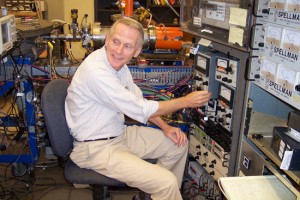Morgan Speaks on Laser-Induced Breakdowns at Plasma Physics Conference

Tom Morgan, Foss Professor of Physics, recently attended the 43rd Institute of Physics U.K. Plasma Physics Conference in Isle of Skye, Scotland. He presented a flash verbal presentation and a poster contribution dealing with the properties of water following focused laser induced breakdown.
After a plasma (a gas of ions and free electrons) is formed in water by laser breakdown, the energy is dissipated through light emission, shockwaves and cavitation bubbles. When the breakdown is close to the surface of the water, surface waves and water ejection from the surface up to heights of 60 cm also occur.
All of these phenomena have been observed in the laboratory at Wesleyan in conjunction with Lutz Huwel, professor of physics, Matt Mei ’18, and international collaborators. Joining the effort from abroad are Professor Tomoyuki Murakami, Seikei University, Tokyo, and Professor Bill Graham, Queen’s University, N. Ireland.
New effects not seen before have been observed, particularly near the surface at the air-water interface. The air-water interface is ubiquitous with applications to biology, environmental studies, chemical analysis and medicine, but its detailed behavior under different conditions is not well understood. The research uses both state of the art computer simulation and experimentation to elucidate the evolutionary dynamics and structure of bulk water and the air-water interface.
“Since the meeting was in Scotland, the researchers though it appropriate to try a liquid other than water and results were reported on whiskey as well,” Morgan said.

